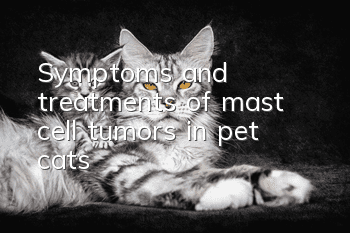Symptoms and treatments of mast cell tumors in pet cats

What are the causes of mast cell tumors in cats
Mast cell tumor is a common disease in dogs and cats. The disease is caused by the hypertrophy of connective tissue cells. The reason why it turns into a tumor is still unclear. Feline mast cell tumor can occur in young cats, so some people think that it may be related to the feline leukemia (details) virus like other leukemias, but there is no evidence yet.
Most mast cells can be seen in acupuncture biopsy of tumor tissue, but mast cells also exist in normal skin tissue, so attention should be paid to identification. Detection of mast cells in blood: After neutral methylene blue staining, mast cells show obvious basophilic staining, which can be clearly seen under a low-power microscope. If ordinary dyeing methods are used, it is easy to miss it during observation due to the disintegration of particles and poor dyeability. Generally, when the number of cells is small, it is more common to miss out when observing neutral methylene blue stained specimens under the entire field of view with a low-power microscope.
Staining method shows that red blood cells are not stained, but white blood cells and platelets are stained. Eosinophils are not stained, but can be observed as folded particles. In addition, reticulocytes were also clearly stained. Mast cells are obviously densely stained, larger than monocytes, and can be clearly seen under low magnification.
What are the symptoms of mast cell tumor
Mast cell tumor is a malignant skin tumor that is prone to occur in cats and dogs, and dogs are more likely to develop it than cats. However, the symptoms, treatment and care of dogs and cats suffering from this disease are quite different and need to be treated separately. So let’s take a look at the symptoms of mast cell tumor in cats.
1. Cutaneous type: multiple relatively soft tumors with a diameter of 0.5 to 1.0cm.
2. Visceral type: Abdominal distension caused by abdominal tumors (splenomegaly, hepatoma) and ascites.
3. Loss of appetite and vomiting (caused by gastrointestinal ulcers).
4. Lack of energy.
5. Melena (duodenal and gastric ulcer caused by histamine and 5-hydroxytryptamine secreted by mast cells).
6. Symptoms of peritonitis (fever, abdominal pain, ascites, vomiting, diarrhea, and rapid death, etc.) caused by gastrointestinal ulcer perforation occasionally occur.
How to treat mast cell tumor in cats
First of all, we must confirm the disease. We should perform fine needle aspiration on the lesion to judge. For this disease, if the cells are well differentiated, the tumor will generally not metastasize. Otherwise, the tumor will metastasize, causing serious harm to the cat. However, if treated promptly, it can be well controlled.
This disease has different treatments depending on the situation:
1. Surgical removal: It is effective when the tumor is relatively localized, has no metastasis or mast cells are not visible in the blood. Combination treatment with cryosurgery is particularly recommended.
2. Radiotherapy: Mast cell tumors are very sensitive to radiation. 3500-5000rADs is the effective dose, and the cure rate is about 50%. Surgical resection after irradiation will have better results.
3. Chemotherapy: Effective for metastatic and systemic conditions. It is better to use medicines 1, 2, and 3 below in combination, but medicine 3 alone also has certain effects. 1. Vinblastine, 2mg/m2, intravenous injection, once a week. 2. Cyclophosphamide 50mg/m2, taken orally, once a day, 4 times a week. 3. Prednisolone 20mg/m2, taken orally, twice a day, every other day.
4. Prevent the formation of gastrointestinal ulcers: Neostigmine antagonist 2 to 4 mg/kg can be taken orally once every 8 hours.
- A cat will die if it urinates for a few days
- Should you deworm yourself or go to a pet store?
- Are cat teasers harmful to cats?
- What should I do if my cat suffers from chronic gingivitis?
- Cat's nails are cracked with a thin layer
- Cats go crazy after eating mutton
- What does cat moss on a cat’s chin look like?
- Can cats reproduce after abdominal transmission is cured?
- What exactly is the sterilization shot for female cats?
- Can I still eat unopened cat food if it has expired?



